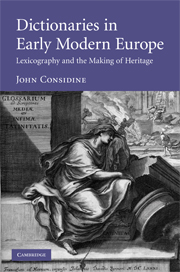Book contents
- Frontmatter
- Dedication
- Contents
- Acknowledgements
- Conventions and abbreviations
- Chapter 1 Introduction
- Chapter 2 The classical heritage I: Philology and lexicography
- Chapter 3 The classical heritage II: Henri Estienne and his world
- Chapter 4 Vernacular heritages I: Germany and the Netherlands 1500–1618
- Chapter 5 Vernacular heritages II: England to circa 1650
- Chapter 6 Vernacular heritages III: England and Scandinavia, circa 1650–1675
- Chapter 7 Post-classical heritages: Du Cange and his world
- Chapter 8 Shared heritages: Polyglot and universal dictionaries
- Conclusion
- Afterword
- Bibliography
- Index
Chapter 5 - Vernacular heritages II: England to circa 1650
Published online by Cambridge University Press: 22 September 2009
- Frontmatter
- Dedication
- Contents
- Acknowledgements
- Conventions and abbreviations
- Chapter 1 Introduction
- Chapter 2 The classical heritage I: Philology and lexicography
- Chapter 3 The classical heritage II: Henri Estienne and his world
- Chapter 4 Vernacular heritages I: Germany and the Netherlands 1500–1618
- Chapter 5 Vernacular heritages II: England to circa 1650
- Chapter 6 Vernacular heritages III: England and Scandinavia, circa 1650–1675
- Chapter 7 Post-classical heritages: Du Cange and his world
- Chapter 8 Shared heritages: Polyglot and universal dictionaries
- Conclusion
- Afterword
- Bibliography
- Index
Summary
A fervent love to my Contrey: The rediscovery of Old English in the sixteenth century
In England, as in Germany and the Netherlands, there was a substantial production of Latin–vernacular and vernacular–Latin dictionaries in the fifteenth and early sixteenth centuries. The first of any importance – the Medulla grammatice, the Hortus vocabulorum and the Promptorium parvulorum – appeared in the first half of the fifteenth century, and can perhaps be associated with the rising prestige of the English language under the Lancastrian kings. They were succeeded from the second quarter of the sixteenth century onwards by a tradition of dictionaries showing humanistic influence: this begins with the first edition of the Dictionary of Sir Thomas Elyot in 1538, a work indebted to Calepino, and continues with a revision by Elyot of the same work, published as the Bibliotheca Eliotae in 1545. The tradition was then continued by an Oxford schoolmaster, Thomas Cooper, and by lexicographers indebted to him. It would be possible to trace the development of the aims of these bilingual dictionaries from the elucidation of Latin texts to the increasingly confident display of the riches of English vocabulary and phraseology.
- Type
- Chapter
- Information
- Dictionaries in Early Modern EuropeLexicography and the Making of Heritage, pp. 156 - 202Publisher: Cambridge University PressPrint publication year: 2008

